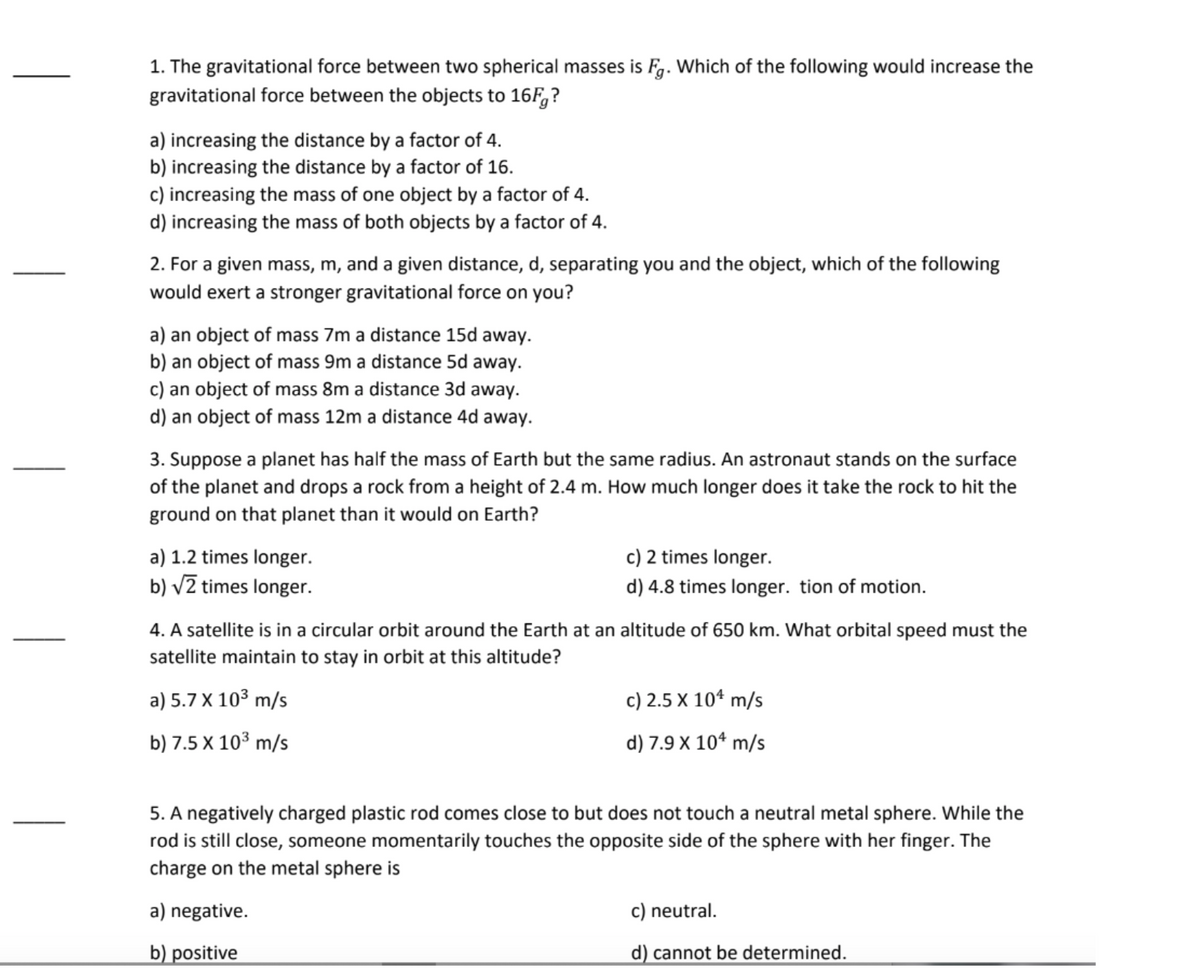1. The gravitational force between two spherical masses is Fg. Which of the following would increase the gravitational force between the objects to 16F,? a) increasing the distance by a factor of 4. b) increasing the distance by a factor of 16. c) increasing the mass of one object by a factor of 4. d) increasing the mass of both objects by a factor of 4.
1. The gravitational force between two spherical masses is Fg. Which of the following would increase the gravitational force between the objects to 16F,? a) increasing the distance by a factor of 4. b) increasing the distance by a factor of 16. c) increasing the mass of one object by a factor of 4. d) increasing the mass of both objects by a factor of 4.
College Physics
10th Edition
ISBN:9781285737027
Author:Raymond A. Serway, Chris Vuille
Publisher:Raymond A. Serway, Chris Vuille
Chapter4: The Laws Of Motion
Section4.3: Newton's Second Law
Problem 4.3QQ: Respond to each statement, true or false: (a) No force of gravity acts on an astronaut in an...
Related questions
Question
Pls help on all

Transcribed Image Text:1. The gravitational force between two spherical masses is Fg. Which of the following would increase the
gravitational force between the objects to 16F,?
a) increasing the distance by a factor of 4.
b) increasing the distance by a factor of 16.
c) increasing the mass of one object by a factor of 4.
d) increasing the mass of both objects by a factor of 4.
2. For a given mass, m, and a given distance, d, separating you and the object, which of the following
would exert a stronger gravitational force on you?
a) an object of mass 7m a distance 15d away.
b) an object of mass 9m a distance 5d away.
c) an object of mass 8m a distance 3d away.
d) an object of mass 12m a distance 4d away.
3. Suppose a planet has half the mass of Earth but the same radius. An astronaut stands on the surface
of the planet and drops a rock from a height of 2.4 m. How much longer does it take the rock to hit the
ground on that planet than it would on Earth?
a) 1.2 times longer.
c) 2 times longer.
b) V7 times longer.
d) 4.8 times longer. tion of motion.
4. A satellite is in a circular orbit around the Earth at an altitude of 650 km. What orbital speed must the
satellite maintain to stay in orbit at this altitude?
a) 5.7 X 103 m/s
c) 2.5 X 10* m/s
b) 7.5 X 103 m/s
d) 7.9 X 10* m/s
5. A negatively charged plastic rod comes close to but does not touch a neutral metal sphere. While the
rod is still close, someone momentarily touches the opposite side of the sphere with her finger. The
charge on the metal sphere is
a) negative.
c) neutral.
b) positive
d) cannot be determined.
|
|
Expert Solution
This question has been solved!
Explore an expertly crafted, step-by-step solution for a thorough understanding of key concepts.
This is a popular solution!
Trending now
This is a popular solution!
Step by step
Solved in 3 steps

Knowledge Booster
Learn more about
Need a deep-dive on the concept behind this application? Look no further. Learn more about this topic, physics and related others by exploring similar questions and additional content below.Recommended textbooks for you

College Physics
Physics
ISBN:
9781285737027
Author:
Raymond A. Serway, Chris Vuille
Publisher:
Cengage Learning


College Physics
Physics
ISBN:
9781938168000
Author:
Paul Peter Urone, Roger Hinrichs
Publisher:
OpenStax College

College Physics
Physics
ISBN:
9781285737027
Author:
Raymond A. Serway, Chris Vuille
Publisher:
Cengage Learning


College Physics
Physics
ISBN:
9781938168000
Author:
Paul Peter Urone, Roger Hinrichs
Publisher:
OpenStax College

Physics for Scientists and Engineers: Foundations…
Physics
ISBN:
9781133939146
Author:
Katz, Debora M.
Publisher:
Cengage Learning

Principles of Physics: A Calculus-Based Text
Physics
ISBN:
9781133104261
Author:
Raymond A. Serway, John W. Jewett
Publisher:
Cengage Learning

College Physics
Physics
ISBN:
9781305952300
Author:
Raymond A. Serway, Chris Vuille
Publisher:
Cengage Learning